Table of Contents
Introduction to Canine Dental Health
When it comes to the well-being of our furry friends, dental health often takes a backseat. However, just like us, dogs also need proper dental care to avoid pain, infection, and other health issues. Dental issues in dogs can lead to discomfort, behavioural changes, and even systemic health problems if left unchecked. a lot of dog owners wonder, “Can my dog get cavities?” Since dog dental care might seem less complex than human dental care, many assume cavities aren’t a risk. Understanding canine dental health and the truth about cavities is essential to helping keep your dog comfortable, healthy, and happy.
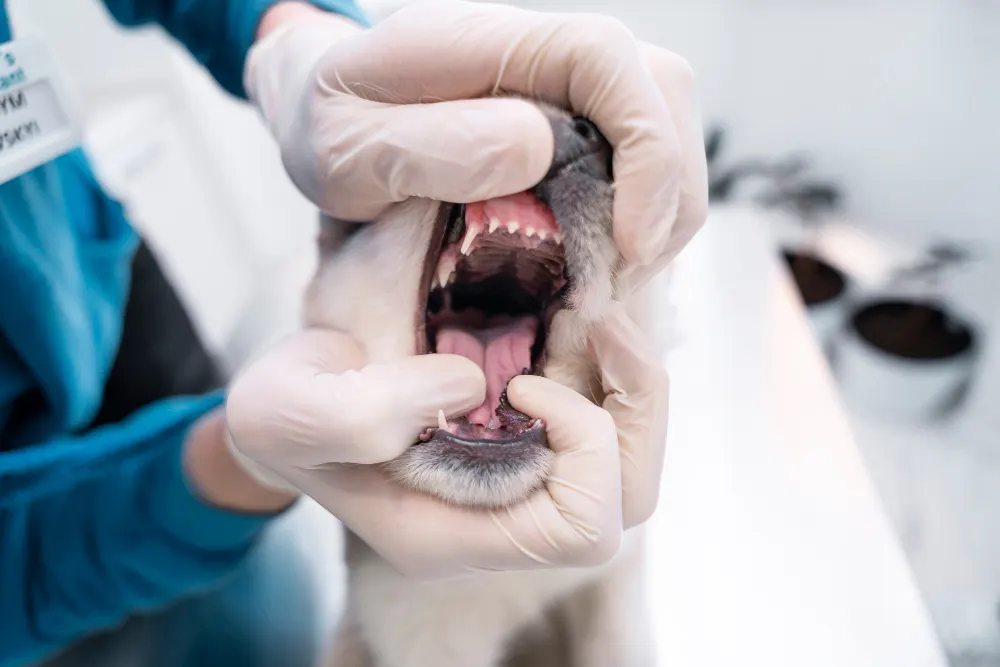
What Are Cavities? Understanding the Basics
Definition of Cavities and How They Develop
Cavities are small holes that form in the hard surface of teeth due to bacterial activity. They occur when plaque, a sticky film of bacteria, accumulates on the tooth surface and produces acids that break down the enamel over time. In humans, cavities are often the result of a diet high in sugars and carbohydrates, which bacteria feed on and convert into decay-causing acids.
Comparison of Human and Dog Cavities
While humans are prone to cavities due to diets often high in sugars and acidic drinks, dog diets typically contain minimal sugars, reducing the likelihood of cavity formation. However, cavities are not entirely impossible in dogs, though they are rare. When cavities do occur in dogs, they are usually small and manageable compared to human cavities.
Bacteria’s Role in Tooth Decay
The primary cause of cavities in both dogs and humans is bacteria, which feed on food residues and sugars on teeth. Bacteria convert these sugars into acids that can erode tooth enamel, leading to decay. However, because most dog foods lack the high sugar content that fuels cavity-forming bacteria, dogs are at a reduced risk.
Can Dogs Get Cavities? The Short Answer
While dogs can get cavities, it’s rare. Veterinarians report that fewer than 10% of canine dental issues involve cavities, with other conditions like periodontal disease and gingivitis being far more common. For most dogs, cavities are infrequent due to natural defences in their mouth and specific diet considerations that don’t promote cavity formation.
Why Are Cavities Rare in Dogs? Key Differences in Oral Health
Dog Saliva and Its Natural Benefits
Dog saliva contains enzymes that help neutralize acids and slow bacterial growth, which provides a natural defence against tooth decay. Additionally, the pH level in a dog’s mouth is typically more alkaline than in humans, further reducing acid formation.
Differences in Diet and Eating Habits
A dog’s diet is generally high in protein and low in carbohydrates and sugars, unlike many human diets. Since cavity-causing bacteria thrive on sugars, this low-sugar intake plays a significant role in the rarity of dog cavities. Moreover, dogs do not frequently snack or consume sugary treats like humans do, which minimizes the amount of bacteria-friendly residues on their teeth.
Tooth Structure and Alignment in Dogs
Dog teeth are more spaced out than human teeth, which makes it harder for food particles to become trapped and form the plaque that leads to cavities. The structure of their teeth and alignment in the mouth also make it easier for debris to be naturally cleaned away when chewing, especially when using dental chews or toys.
Anatomy of a Dog’s Mouth and Teeth
Structure and Type of Dog Teeth
Dogs have four types of teeth—incisors, canines, premolars, and molars—each adapted for different functions, like tearing, cutting, and grinding food. This diverse structure and spacing help reduce the risk of food buildup between teeth, lowering the chance of bacterial growth and, thus, cavities.
How Dog Teeth Are Less Prone to Cavities
The anatomy of a dog’s teeth, combined with a mouth designed to tear and chew rather than grind, is less conducive to plaque buildup. Because dogs primarily chew through harder substances, like kibble or bones, they naturally scrape off plaque buildup that would otherwise lead to cavities.
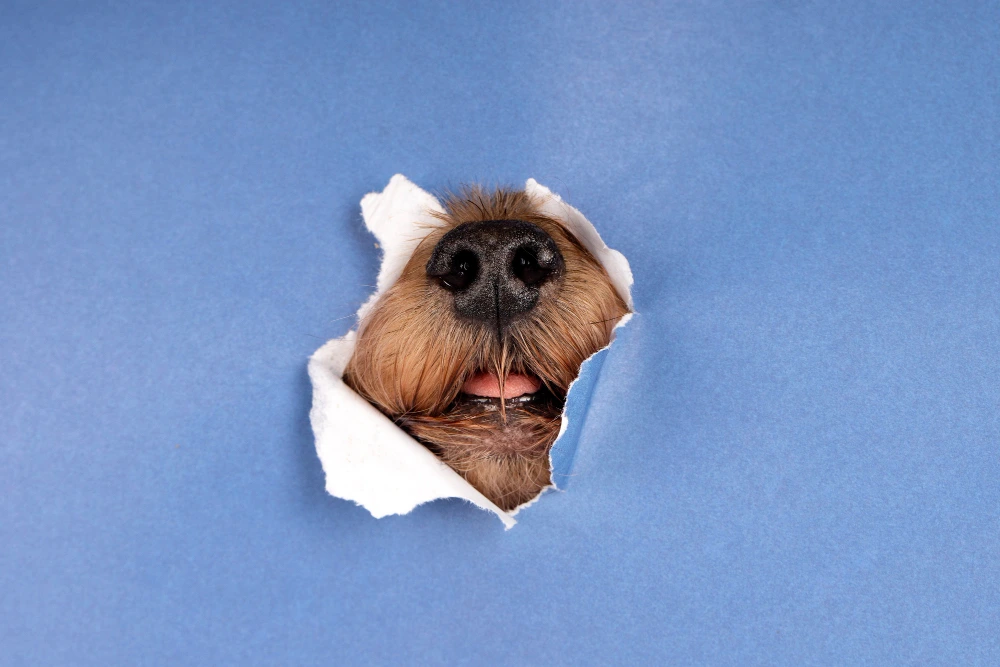
Role of Diet in Reducing Cavity Risk
Typical Dog Diet and Its Low Sugar Content
The typical dog diet is specifically formulated to be nutritious without sugars, which are the primary fuel for bacteria that cause cavities. Commercial dog foods and diets focused on meat, protein, and grains, with little to no sugar content, help create an oral environment unfavourable to cavity development.
Foods That Contribute to Dog Dental Health
Some foods and dog treats are specifically formulated to improve dental health by mechanically cleaning the teeth as dogs chew. Dental-friendly dog treats are often textured to aid in removing plaque and even include ingredients that freshen breath and further reduce bacteria in the mouth.
Common Dental Issues in Dogs Besides Cavities
Periodontal Disease in Dogs
Periodontal disease is a more prevalent problem in dogs than cavities. It occurs when plaque builds up along the gumline, leading to inflammation, gum infection, and tooth loss if untreated. Without regular cleaning, periodontal disease can significantly impact a dog’s quality of life.
Gingivitis and Plaque Buildup
Gingivitis, the early stage of periodontal disease, involves gum inflammation and bleeding due to plaque accumulation. Unlike cavities, gingivitis can be quite painful for dogs, leading to discomfort while eating and playing. Regular cleanings can help prevent this condition.
Tooth Fractures and Worn-Down Teeth
Dogs frequently suffer from worn-down teeth due to chewing on hard objects like bones or toys. They may also experience fractures from aggressive chewing. Unlike cavities, these issues stem more from physical wear than bacterial decay but are still a significant dental health concern.
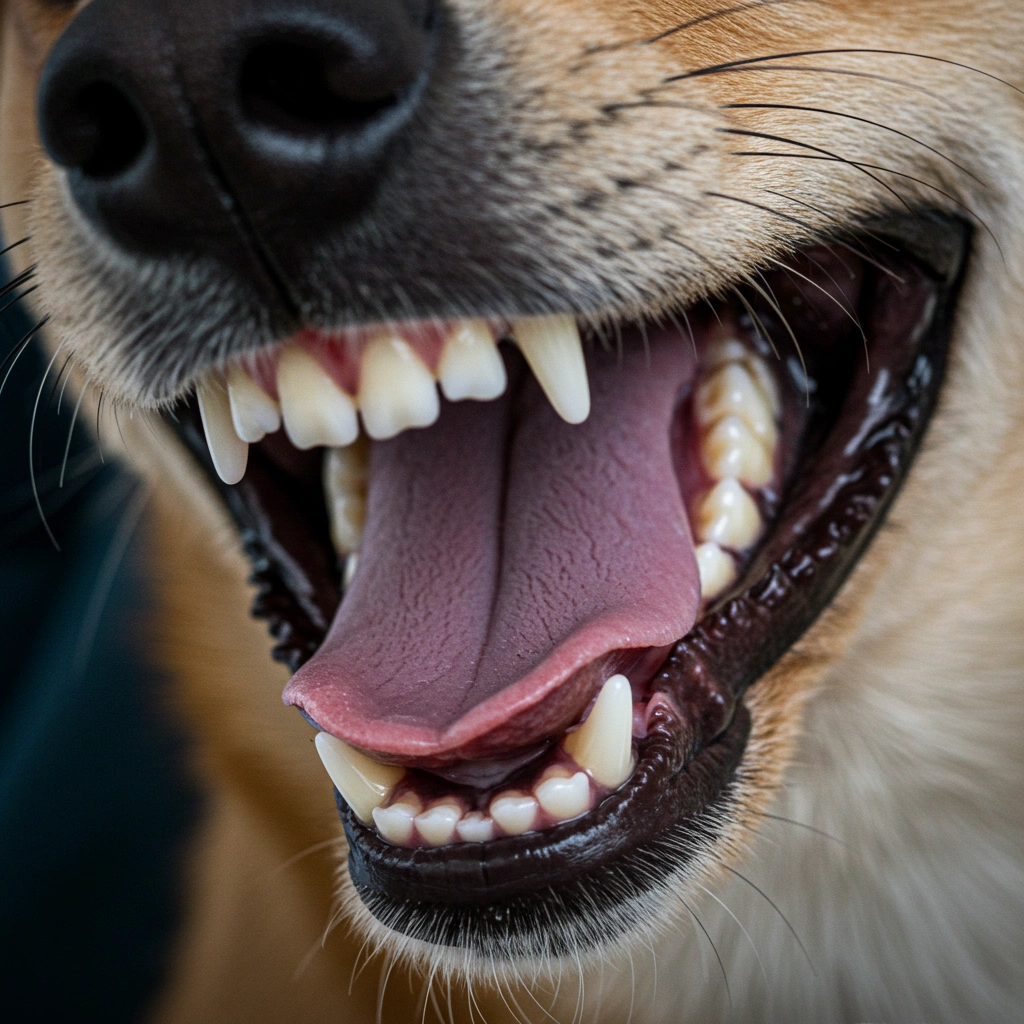
Symptoms of Dental Problems in Dogs
Key Signs That Indicate Dental Pain or Issues
Dogs can’t tell us when their teeth hurt, but there are specific signs that suggest dental issues. One of the most common indicators is a change in eating habits. If a dog appears reluctant to chew, drops food from its mouth, or only chews on one side, it could be a sign of dental pain. Another key sign is excessive drooling or drooling with traces of blood, which may point to gum disease or an infected tooth.
Behavioural Changes Linked to Dental Discomfort
Dogs experiencing dental pain may show behavioural shifts, like avoiding playtime, being reluctant to chew on toys, or showing irritability when their mouth is touched. They might also become more reserved and less interactive, signalling discomfort. Bad breath, or halitosis, is another common sign that there could be something wrong. While a bit of dog breath is normal, a strong or foul smell may indicate bacterial buildup or an underlying infection.
Symptoms of Cavities or Tooth Decay in Dogs
Though rare, cavities in dogs can cause symptoms like visible pits or dark spots on the teeth, bad breath, and visible discomfort when eating. If the cavity progresses, the dog may show signs of swelling around the mouth or face. Regularly checking a dog’s teeth for unusual dark spots or changes in texture can help catch any potential issues early.
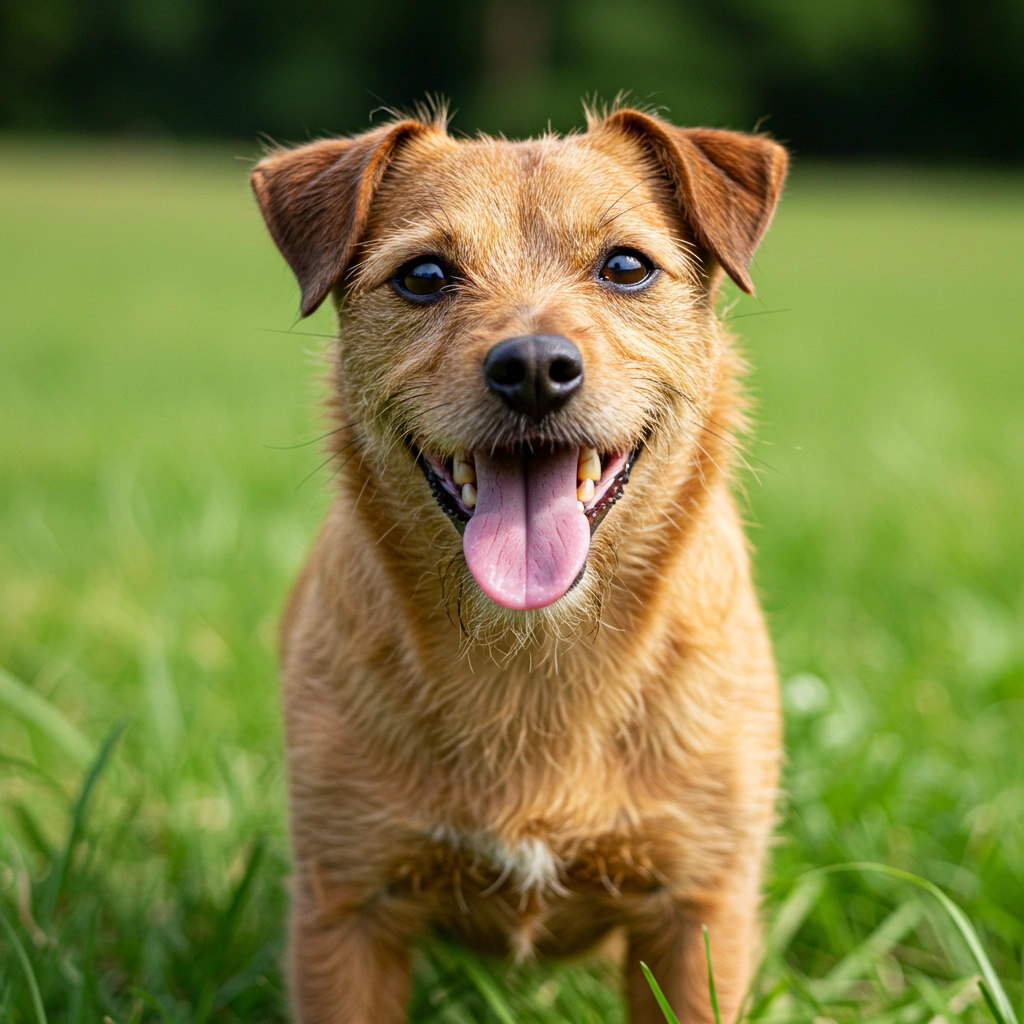
Prevention of Cavities and Dental Problems in Dogs
Importance of Regular Brushing and Cleaning
One of the best preventive measures for your dog’s dental health is regular tooth brushing. While it might seem like a challenge at first, many dogs can get used to brushing if it’s done gently and with positive reinforcement. Brushing helps remove plaque and bacteria, reducing the risk of not just cavities but also gum disease and other oral infections.
Benefits of Dog Dental Treats and Chews
Dental treats and chews are specially designed to mechanically clean a dog’s teeth as they chew, helping to dislodge food particles and reduce plaque buildup. Many dental chews are textured to rub against the teeth and gums, and some even contain ingredients that freshen breath or have antibacterial properties. Regularly giving your dog dental chews can be an effective supplement to brushing.
Routine Veterinary Checkups for Dental Health
Routine checkups with a veterinarian are essential for spotting any early signs of dental issues that may go unnoticed. During a dental exam, a vet can assess the health of a dog’s teeth and gums, check for any plaque buildup or decay, and recommend treatments if needed. Regular vet visits can help identify problems before they become serious, ensuring that your dog’s mouth stays healthy and pain-free.
How Often Should You Brush Your Dog’s Teeth?
Guidelines for Frequency of Brushing
For optimal dental health, it’s recommended to brush a dog’s teeth at least two to three times per week, though daily brushing is ideal. Starting with shorter sessions and gradually increasing time as the dog becomes comfortable can make brushing a manageable habit. Using a soft-bristled toothbrush and pet-safe toothpaste (never human toothpaste) is essential, as human products can be harmful if swallowed.
Choosing the Right Dog Toothpaste and Tools
Pet-safe toothpaste comes in dog-friendly flavours like poultry or peanut butter, making it easier to introduce brushing as a positive experience. There are also different types of toothbrushes, including finger brushes and dual-headed brushes, which can be more convenient depending on the dog’s size and temperament. Choosing the right tools helps ensure that brushing is both effective and safe for your pet.
Recommended Dental Chews and Toys
Types of Chews That Aid in Cleaning Teeth
There are various types of dental chews on the market, from edible chews infused with enzymes to durable toys designed for gnawing. Chews like Greenies or dental sticks are popular for their breath-freshening properties and can help reduce plaque and tartar. Rope toys and rubber chews are also excellent options, as they naturally rub against teeth, helping to reduce plaque buildup.
Choosing Toys That Support Dental Hygiene
Not all toys are beneficial for dental health. Opt for toys made of soft yet durable rubber, which can help clean teeth without causing damage. Avoid overly hard toys, like certain bones or nylon toys, as these can lead to tooth fractures. Rope toys, when used under supervision, can also be beneficial as the fibres work like dental floss, and scraping teeth as the dog chews and plays.
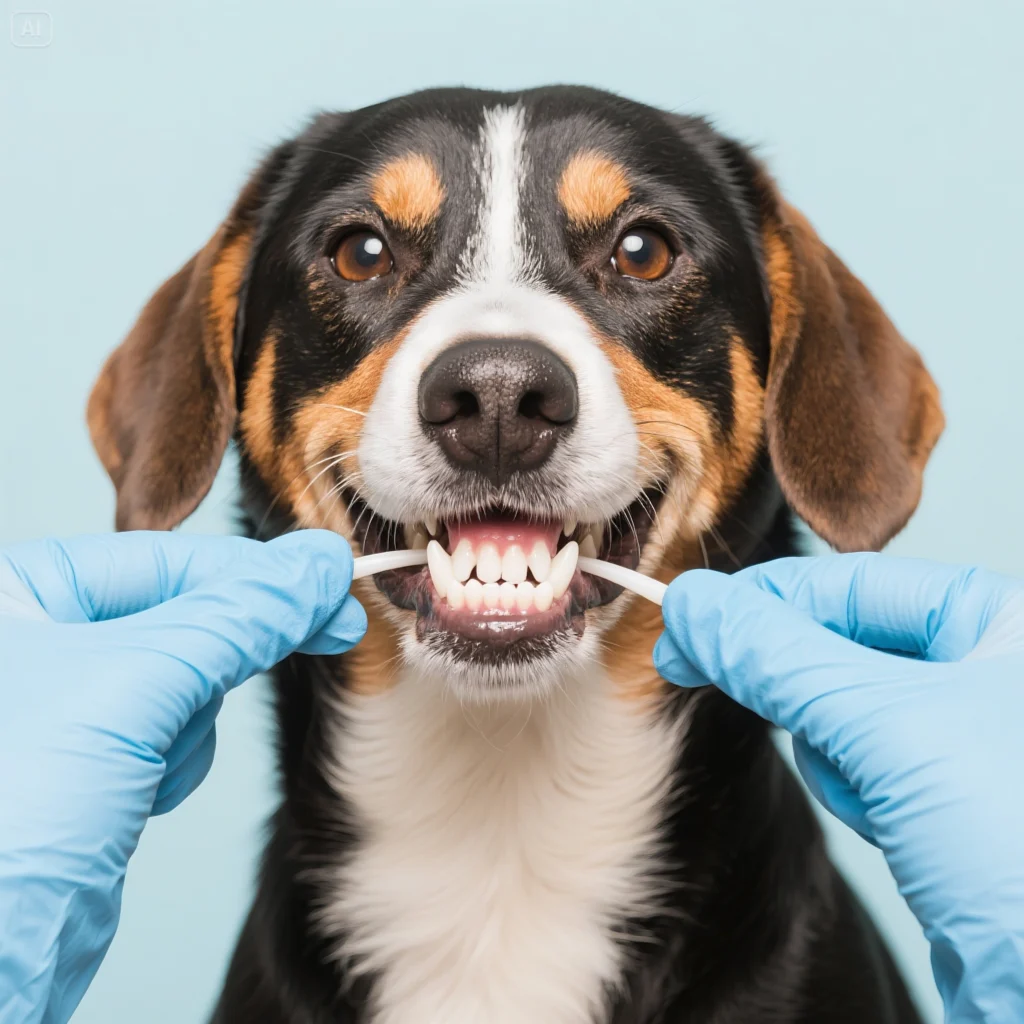
Professional Dental Care for Dogs
When and Why Professional Cleanings Are Necessary
Despite a good home care routine, professional dental cleanings are recommended for most dogs once a year. During a professional cleaning, veterinarians can remove tartar and plaque that at-home care may miss. They can also take X-rays to assess the roots and areas below the gum line for signs of disease or damage. Professional cleanings can prevent serious dental issues and improve a dog’s overall health.
Process of Dental Exams and Cleaning in Vet Clinics
A typical dental cleaning includes scaling (removing tartar and plaque), polishing, and sometimes fluoride treatment to protect the teeth. Some vets may also apply sealants to prevent bacteria from sticking to the teeth. Vets will examine each tooth closely and check for signs of gingivitis, decay, or fractured teeth, providing a thorough cleaning that’s difficult to achieve at home.
Understanding Anesthesia in Dog Dental Cleanings
Reasons for Anesthesia Use During Cleanings
To ensure a safe and effective cleaning, veterinarians often use anaesthesia to prevent stress or discomfort during the procedure. Anesthesia allows vets to clean below the gum line, where most dental disease originates, and take accurate X-rays. Though anaesthesia carries some risks, veterinary teams carefully monitor the dog to ensure a smooth procedure.
Safety and Considerations for Pet Owners
Many pet owners worry about the risks of anaesthesia, especially in older dogs. However, vets assess each dog’s health before recommending anaesthesia. Blood tests, physical exams, and sometimes EKGs are performed to minimize risks. Anesthesia ensures a thorough and pain-free cleaning, making it safer for both the dog and the vet.
Natural Remedies for Improving Dog Dental Health
Safe, At-Home Options for Dental Care
Several natural options can help maintain a dog’s oral hygiene. Coconut oil, for example, has antibacterial properties and can be applied to the gums to help reduce bacteria. Mixing a bit of apple cider vinegar into a dog’s water can also aid in balancing mouth pH, but it should be used sparingly. Always check with a vet before introducing new items into your dog’s dental care routine.
Popular Natural Dental Care Methods and Supplements
Some pet owners use specific foods, like carrots or apples, as natural teeth cleaners. Raw, crunchy vegetables help scrape off plaque and can be a fun treat. There are also dental supplements available, such as powders that can be added to food to help reduce plaque and tartar buildup. While natural remedies can be helpful, they work best in conjunction with brushing and vet checkups.
Myths About Dog Dental Health and Cavities
Common Misconceptions About Dog Cavities
One common myth is that dogs don’t need dental care because their diet protects them. While a dog’s diet does contribute to lower cavity risk, it doesn’t eliminate the need for brushing and checkups. Another misconception is that dog breath is naturally bad, which is false; persistent bad breath can be a sign of oral health issues.
Clarifying Myths on Dog Dental Hygiene
Some owners believe that dogs can clean their teeth by chewing bones alone, but bones can cause fractures and other dental injuries. Additionally, relying solely on dental chews without brushing is insufficient for long-term dental health. A balanced approach with multiple methods is the best way to ensure a dog’s mouth remains healthy.
Importance of Regular Dental Checkups
Benefits of Regular Dental Exams
Regular dental exams help catch problems early, prevent pain, and extend a dog’s life expectancy. During these checkups, vets can detect issues like gum disease, fractured teeth, or infections before they worsen. Routine checkups are essential to maintain a dog’s dental and overall health.
What Vets Look for in a Dental Checkup
During a checkup, vets will examine each tooth, look for plaque buildup, check gum health, and assess for any signs of oral cancer or infections. They’ll also provide guidance on home care and may recommend cleanings or other treatments if they spot issues that require attention.
Conclusion: Ensuring Your Dog’s Dental Health
Caring for your dog’s teeth is an essential part of keeping them healthy and happy. While cavities are rare in dogs, other dental issues like periodontal disease are common and can cause significant pain if left untreated. By brushing regularly, providing dental-friendly treats and toys, and scheduling regular checkups, you can help your dog maintain strong, healthy teeth. Investing time in your dog’s dental care today ensures they enjoy a comfortable, active life for years to come.
FAQs
Can dogs get toothaches like humans?
Yes, dogs can experience toothaches due to conditions like fractures, infections, or gum disease. If a dog is showing signs of discomfort, such as avoiding food or not playing with toys, it may be experiencing dental pain.
Is bad breath in dogs a sign of cavities?
Bad breath can be an indication of various dental issues, including plaque buildup or gum disease, but it’s not typically a direct sign of cavities in dogs. Persistent bad breath should be checked by a vet to rule out any underlying issues.
Are there specific breeds more prone to dental issues?
Yes, certain breeds, particularly small breeds like Chihuahuas, Dachshunds, and Toy Poodles, are more susceptible to dental problems due to their jaw structure and tooth crowding.
Can a dog’s diet completely prevent cavities?
A diet low in sugars and carbohydrates helps reduce the risk of cavities, but it doesn’t entirely prevent all








